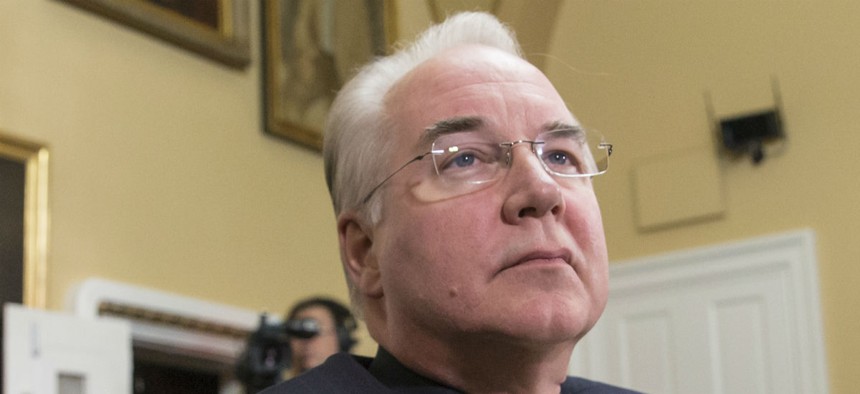
Rep. Tom Price, R-Ga., chairman of the House Budget Committee. J. Scott Applewhite/AP
House Republican Budget Would Revive Cuts to Feds’ Pay and Benefits
Fiscal 2017 blueprint also calls for more firings, demotions and suspensions.
In their fiscal 2017 budget proposal unveiled Tuesday, House Republicans removed some of the previously included provisions targeting federal employees for deficit reduction, though they still plan to bring back other cuts to civil servants’ compensation.
Absent from the blueprint authored by House Budget Committee Chairman Tom Price, R-Ga., was a provision requiring federal workers to contribute more to their pensions, as originally proposed in the National Commission on Fiscal Responsibility and Reform, or the Simpson- Bowles report. Price’s fiscal 2016 proposal asked -- as did previous blueprints authored by his predecessor, current House Speaker Paul Ryan, R-Wis. -- feds to split the Federal Employees Retirement System contribution with their agencies, amounting to a 6.35 percent paycheck deduction.
Federal employees are not out of congressional Republicans’ crosshairs yet; the budget committee will mark up its plan on Wednesday, and a forthcoming report spelling out more specifically how they will reach $6.5 trillion in savings over the next 10 years will identify savings at the expense of the federal workforce. A committee aide told Government Executive the budget will assume the same savings from federal employees as were included last year.
The original fiscal 2016 budget to come out of the committee targeted feds for $280 billion in savings, through the contribution hike; eventually phasing out the defined benefit altogether; ending the Social Security supplement for young retirees; limiting the return rate of the Thrift Savings Plan’s government securities (G) fund; using attrition to cut the workforce by 10 percent; tying government's share of health care premiums for retirees to inflation, rather than cost of plan; tying retirees' health benefits to length of service; and a variety of reforms to postal employees’ benefits.
Congress has already raised the pension contribution level for newer employees twice in recent years, creating a three-tiered system in which employees pay between 0.8 percent and 4.4 percent of their paychecks toward their defined benefit, depending when they were hired.
In addition to those pitfalls, federal employees would likely feel the general purse tightening from the budget. While the proposal maintains the boosted funding level for fiscal 2017 agreed to last year in the 2015 Bipartisan Budget Act, it would cut non-Defense discretionary spending at federal agencies by $887 billion below sequester levels through fiscal 2026. Such dramatic spending reductions could result in hiring freezes and job losses across government.
Price wrote in his budget that his blueprint reduces federal spending “responsibly,” saying he is simply cutting the rate of growth.
“These reductions are hardly draconian,” the chairman said. “Over the years, Congress has put two-thirds of the budget on auto-pilot, and spending in those areas grows each year.”
The 10-year plan would balance the budget by 2026.
“Washington cannot keep spending money it does not have,” Price said.
Price also promised in his budget to reduce the size of the bureaucracy while holding federal agencies and their employees more accountable. He called for the elimination of “unnecessary, duplicative, and/or inefficient programs and agencies.”
He focused on the Veterans Affairs Department, saying its employees receive too many bonuses and get away with bad behavior.
“With Congress’ help,” Price wrote, “the VA must reform how it holds leaders and supervisors accountable so employees who are corrupt or incompetent are not shielded from being fired, demoted, or suspended.”
Richard Thissen, president of the National Active and Retired Federal Employees Association, wrote a letter to budget committee leaders asking them to “leave feds alone” in their proposal.
“Over the past several years, federal employees endured three years of pay freezes, followed by modest pay raises that did not keep pace with private-sector wage increases,” Thissen wrote. “Please support a budget that reflects the value of our nation’s public servants, provides agencies the funds necessary to avoid furloughs and does not make further unjustified cuts to federal employee compensation and benefits.”
NARFE and other federal employee advocates may find solace from an unlikely source; the conservative House Freedom Caucus has already announced it would not support the budget, putting its passage in serious question. Even if it were to pass, the policy specifics outlined in the budget would serve as a guidelines rather than enacted law.







